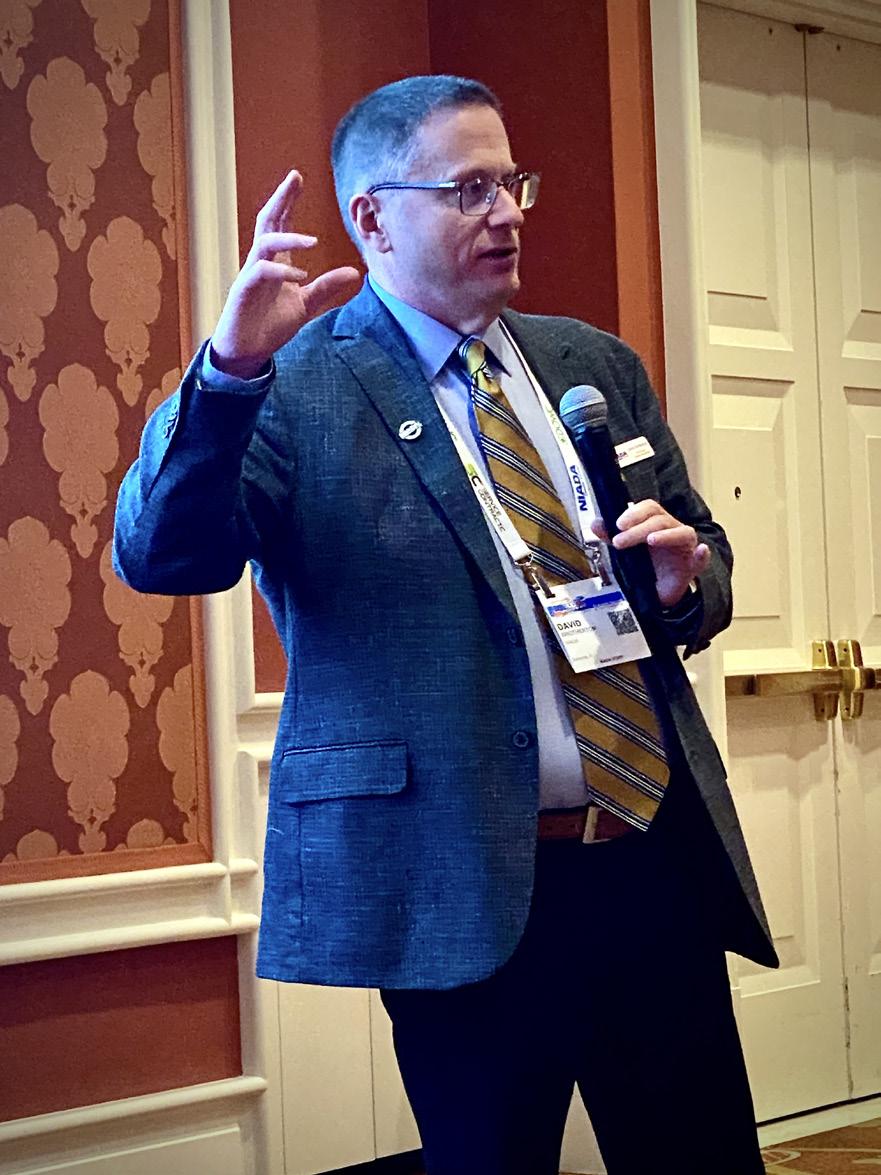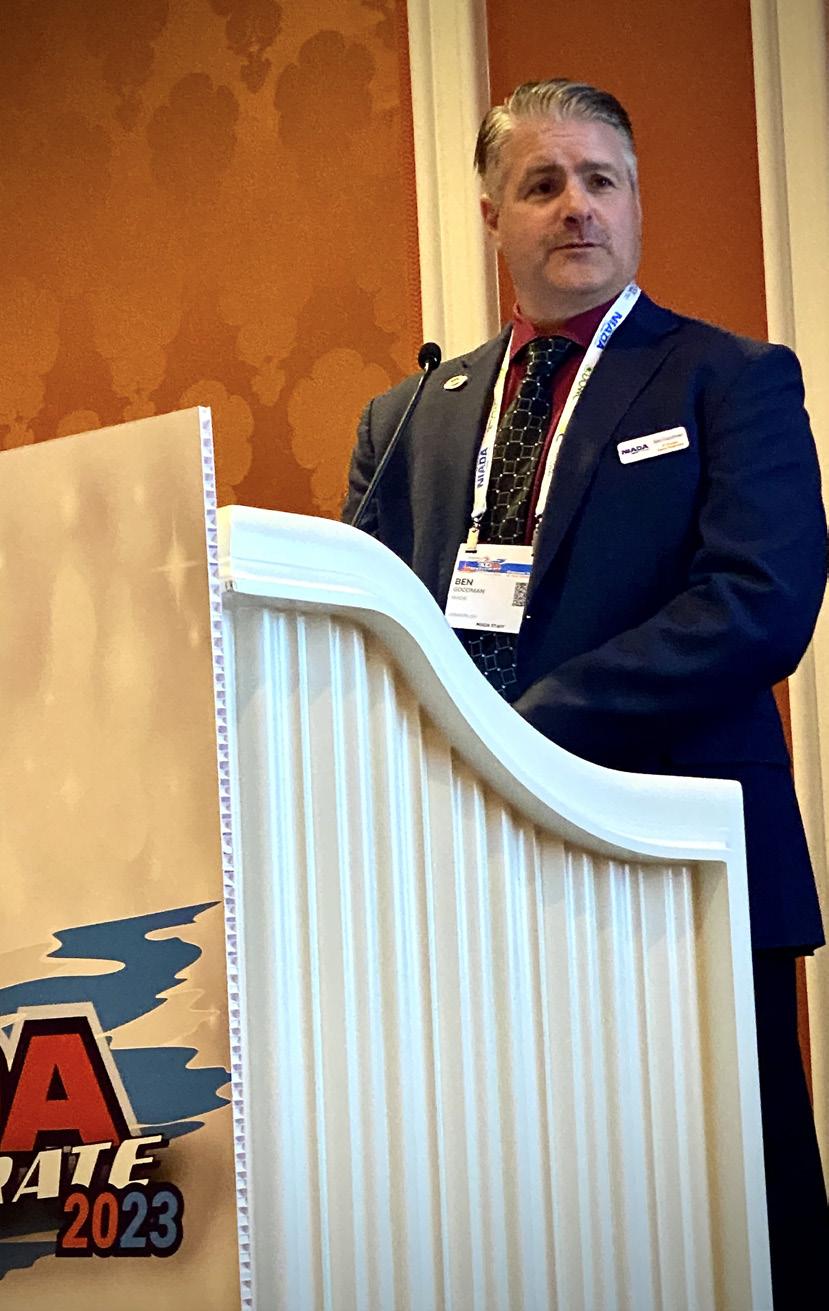
4 minute read
Reconditioning Strong Recon Shops Need Productivity, Efficiency
By Jeffrey Bellant
LAS VEGAS – Experts from the National Independent Automobile Dealers Association discussed ways to save on reconditioning costs during a presentation at NIADA Accelerate.

Ben Goodman and David Brotherton, both senior 20 Group moderators for buy-here, pay-here service groups, led the discussion.
“We have to understand a cost center mindset,” Brotherton said.
A cost center is a department within an organization that does not directly add profit to the company but still costs money to operate.
It’s about balancing time and cost in the “reconditioning cost equation,” and reviewing a service department’s KPIs (key performance indicators) that improve workflow and efficiency, Brotherton said.
Using a group of his clients as an example, their average purchase price jumped to $8,269 in 2023 from $6,777 from 2021. Average recon costs from that same time for the group rose from $1,353 to $1,615 in 2022 before easing to $1,584 in 2023.
The other issue is average mileage, which also went up 30,000.
“With the right focus, you can reduce recon costs,” Goodman said.
Brotherton said it takes a special mindset and set-up to do the “MacGyver- type” repairs.
“You’ve got to have someone who really knows their stuff,” he said. “You’ve got to have someone that you’re OK with in taking the time to do it.”
For example, if your plan is to rebuild transmissions, you’ll need specialized equipment and someone who knows how to do it.
For a dealer who’s selling a lot of cars but has few service bays, Brotherton generally recommends farming out the bigger, more complicated service jobs.
Knowing when it makes sense to repair something yourself – which can be much cheaper in certain cases – or simply replacing the part is a critical part of the decision making process.
“If you know how to do it and you can find the parts and components you need, it’s going to be cheaper in most cases,” Brotherton said. “In many cases, it’s much cheaper.”
Also, dealers with service departments need to determine whether they are going to set up a shop for both reconditioning and customer pay service.
“Does it make sense for us to do this or am I going to tie up too much time, because time is money,” Brotherton said.
The time where a lift or tech is tied up does limit what you can do.
“You have to think about return on investment (ROI) he added. “That’s where you have to balance out, is your shop prepared to repair and can you afford to tie up a bay 16 hours, when the replacement time might only be eight?”
The key is understanding the difference between servicing outside customers or simply doing recon/ service for a BHPH business. A recon job means that the dealer is paying a commission to himself.
Reconditioning work is all about efficiency, Brotherton said.
“It’s about getting as many vehicles to the frontline, the fastest (way) for the least cost, with the greatest amount of consistency,” he said.
KPIs in the service business include efficiency, or how well the tech beats the book. The equation is flat rate hours produced/hours worked. The target range is 125% to 130%, depending on whether you’re using factory time or non-factory time.
Dealers don’t need to pay techs on a flat rate, but it is used for the equation.
But it’s also about productivity, which equates to actual (clock) hours worked/total (clock) hours available. The target range is to have techs actively working on a job at 80% to 85%. It means techs have to clock in and out on the job.
Goodman warned dealers that any tech can be busy but still slow roll the job. That’s why dealers have to look at both productivity and efficiency.
This flows into the issue of “proficiency,” which involves hours worked vs. hours available. The equation in this case is flat rate hours produced/actual (clock) hours worked.
The pair said this is the best mea- sure of a tech’s time and target range should be 100% to 120%.
Brotherton said the bottom line is this:
“There is a cap on how much time is available without extending hours,” he said.
Goodman and Brotherton both stressed that none of these are hard and fast rules. Dealers have to find the right balance for themselves.
“You’re going to find a difference of opinion, even between Dave and I,” Goodman said. “Dave is more of a fan of efficiency while I’m more of a fan of productivity.”
For Goodman, if a dealer is working in a retail service shop, efficiency is key. But running a BHPH shop means you have to keep techs busy, so productivity is king.
Brotherton said the key to keeping a tech productive – outside of measurement – is communication.
“Does your service manager sit at his desk all day on the phone or is he on the floor like he should be, directing traffic and helping the team?” Brotherton said.
Still, it’s about what works for you, he added.
For dealers whose techs are better at just replacing parts, then that’s your focus because that’s the skill level of your techs.
“It’s always going to boil down to your people,” Goodman said. “Do you have the right people in place to perform the duties within your dealership that you need to get done?”
Leadership is critical in making this work, he said.
If a service manager is not engaged with what’s happening on the service floor, it’s going to be difficult to have an efficient shop, Goodman said. Separating customer work from reconditioning work is a good best practice, but it doesn’t work for everyone, Brotherton said. Recon shouldn’t start until all parts are ready. Time and money is lost when a car is put on a lift, but all the parts are not ready for the work.
“It is frustrating and time consuming,” Goodman said.
“You have to run your recon department like an assembly line.”
The optimal set-up is multiple lifts with multiple techs.
Brotherton added that for techs doing customer work, it is critical to have people with better diagnostic skills to prevent customer comebacks.
Service businesses also need inventory tracking tools so techs know what comes next.
Last, dealers should post productivity, efficiency and proficiency metrics daily, weekly and monthly for accountability, Goodman said.








